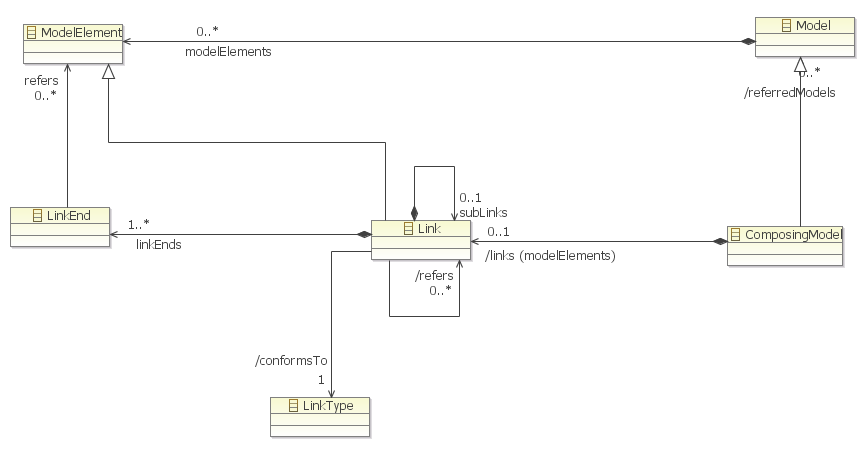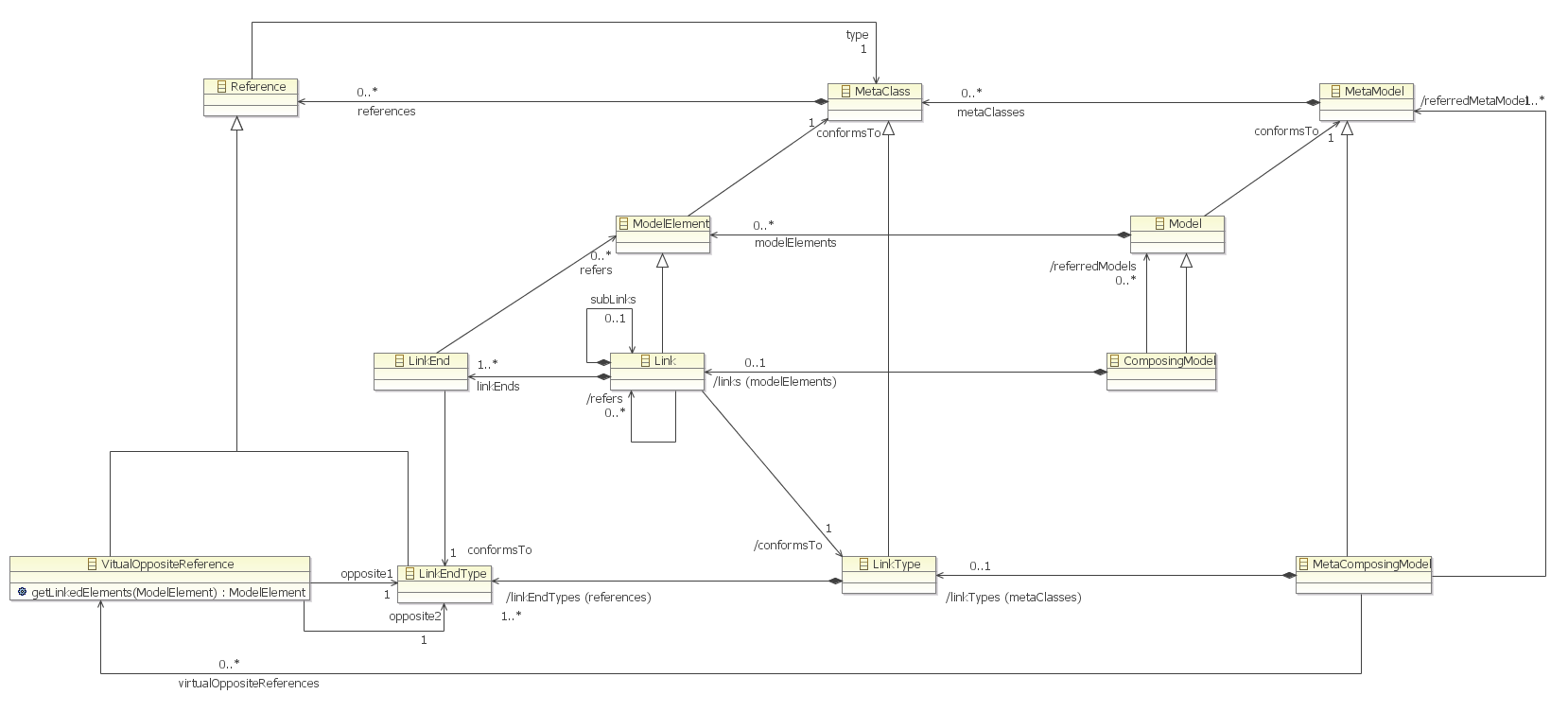Notice: This Wiki is now read only and edits are no longer possible. Please see: https://gitlab.eclipse.org/eclipsefdn/helpdesk/-/wikis/Wiki-shutdown-plan for the plan.
MoDisco/Components/Composition/Architecture
| MoDisco |
| Website |
| Download |
| Community |
| Mailing List • Forums |
| Bugzilla |
| Open |
| Help Wanted |
| Bug Day |
| Contribute |
| Browse Source • Project Set File |
Contents
Requirements
In this document, we use this terms:
- composing model: a group of models,
- composed model: a member of the group of models.
Functional requirements
We need a mechanism to achieve these goals:
- R1. a composing model groups several models together using model element level links
- R2. a composing model establishes links between elements of these models
- 1. links can have different arities
- 2. links can be considered as elements.
- 3. links can have sub links.
- R3. a composing model remain the composed models unchanged
- R4. a composing model remain the metamodels of the composed models unchanged
- R5. a composing model is a model describing which models are in the group and which model elements are linked
- 1. a composing model contains links between model elements
- R6. a composing model conforms to a meta-model.
- 1. the metamodel of the composing model defines the meta-links between the meta-classes.
- 2. each link contained in the composing model conforms to a metalink defined by a metamodel
- R7. a composed model can be a composing model
As we need to add links starting from elements of the composed metamodels without changing these metamodels, we need :
- R8. virtual reference which can be added to composed models to be able to navigate links in the opposite way
Our approach is to create, in a new metamodel (the composing metamodel), elements which could be interpreted as additional links between metaclasses of other metamodels (the composed metamodels). Because in the majority of cases, the referred models are conforms to meta-models that have not been designed to be referred. We then need a mechanism to add “virtual” references to the referred meta-models. We need a "virtual add" because referred meta-model can’t be modified in most use cases. And the use of bidirectional references is not recommended to avoid cycle problems.
- R9. The "virtual" references between model elements should conform to "virtual" links between metaclasses. These "virtual" references, contained in the composing model, should hold all the information required to find the source and the target elements in the composed models.
Non functional requirements
- R10. To be usable by transformation and generation engine based on EMF.
Functional specification
Composing Model
Figure 1 - ComposingModel meta-model
If ComposingModel is kind of Model, this imply that MetaComposingModel is a kind of MetaModel.
Model element to model element links
In the meta-model presented on Figure 2, the class “Link” corresponds to the "link" concept (R2) and the LinkEnd is used to represent the "different arities" (R2.1). The LinkType class corresponds to the link typing (R6.2). The subLinks reference allows a link to have sub links (R2.3).
ComposingModel’s attribute named “referredModels” is a derived attribute (self.referredModels = self.links->collect(e|e.linksEnds->collect(f|f.referes.eContainer()))).
Figure 2 - Link meta-model
The Figure 3 presents the meta-model completed by the following items:
- a link is a kind of ModelElement (R2.2)
- a LinkType is a kind of MetaClass ;
Figure 3 – Main functional class diagram
Summary
| Requirement | Realization |
| R1 a composing model groups several models together using model element level links | ComposingModel::/referredModels |
| R2 a composing model establishes links between elements of these models | ComposingModel::/links |
| R2.1 links can have different arities | Link::linkEnds [1..*] |
| R2.2 links can be considered as elements. | Link extends ModelElement |
| R2.3 links can have sub links. | Link::subLinks |
| R3 a composing model remain the composed models unchanged | LinkEnd::refers has not any opposite. ComposingModel::/referredModels has not any opposite. |
| R4 a composing model remain the metamodels of the composed models unchanged | LinkEndType::type has not any opposite. MetaComposingModel::/referredMetaModels has not any opposite. |
| R5 a composing model is a model describing which models are in the group and which model elements are linked | ComposingModel extends Model, ComposingModel::/referredModels, ComposingModel::/links |
| R5.1 a composing model contains links between model elements | ComposingModel::/links |
| R6 a composing model conforms to a meta-model. | ComposingModel extends Model. MetaComposingModel extends MetaModel. Model::conforms_to : MetaModel |
| R6.1 the metamodel of the composing model defines the meta-links between the meta-classes. | MetaComposingModel extends MetaModel. LinkType extends MetaClass. MetaModel::metaClasses : MetaClass |
| R7 a composed model can be a composing model | ComposingModel extends Model |
| R8 virtual reference which can be added to composed models to be able to navigate links in the opposite way | VirtualOppositeRef::getLinkedElements(ModelElement) |
| R9 The “virtual” references between model elements should conform to “virtual” links between metaclasses. These “virtual” references, contained in the composing model, should hold all the information required to find the source and the target elements in the composed models. | VirtualOppositeRef, VirtualOppositeRef::opposite1, VirtualOppositeRef::opposite2, MetaComposingModel::virtualOppositeReference |



